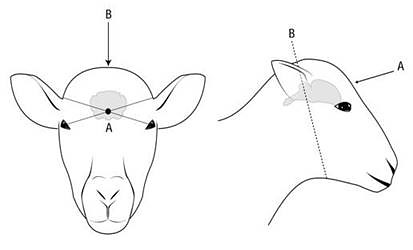Euthanasia of livestock
Euthanasia is not a task that anyone enjoys, but it is sometimes necessary as the only viable option for sick animals that cannot be treated. It is therefore a necessary skill that responsible livestock owners should master to ensure a humane death.
Euthanasia is the deliberate ending of life of an animal suffering from disease, injury or in pain and/or distress. The Australian Animal Welfare Standards and Guidelines for Sheep outlines the requirements for the humane killing of sheep. The Standards include:
- The killing method must result in rapid loss of consciousness followed by death while unconscious.
- The person killing the sheep must have the knowledge, experience and skills to kill the sheep humanely or be under direct supervisor of such a person.
- A sheep suffering from severe distress, disease or injury that cannot be reasonably treated must be killed at the first reasonable opportunity.
- The use of bleeding out by a neck cut to kill a conscious sheep is only permitted when there is no firearm, captive bolt or lethal injection reasonably available.
- Reasonable actions must be taken to confirm that the sheep is dead.
The preferred method for conducting humane killing is the poll method (B). The brainstem is targeted and it lies midway along an imaginary line drawn between the base of the ears.
Confirmation of death is a mandatory part of humane killing. To achieve this, three or more of the following signs should be observed to ensure death has occurred:
- Loss of consciousness and deliberate movement including eye movement; and
- Absence of a corneal ‘blink’ reflex when the eyeball is touched; and
- Maximum dilation of the pupil; or
- Absence of rhythmic respiratory movements for a least five minutes.
The equipment options to perform euthanasia include a firearm or a captive bolt. Firearms are regulated by the Firearms Act 1996 and have strict licensing, registration and regulation on use, ownership and storage. A Captive bolt stunner is the other option and currently, there are no regulatory or licence requirements in Victoria for ownership or storage of a captive bolt humane stunner. They are still a dangerous device but are considered safer than firearms.
Many producers are now using captive bolt stunners on farm because of their relative safety, cost and ease of use. A captive bolt humane stunner has a metal bolt that is powered by a blank cartridge. The bolt penetrates the skull into the brain of the animal and causes disruption of the cerebral cortex and the brainstem, resulting in immediate unconsciousness.
The humane killing of a sheep using a captive bolt stunner requires the sheep to be appropriately restrained. The captive bolt stunner is firmly pressed on the head before being discharged (position for placement are shown in the diagram. This is followed by an effective procedure (if necessary, such as a neck cut (bleeding out) or pithing) to ensure death. Death must be confirmed using the list above.
If you are interested in purchasing a captive bolt stunner, several outlets sell these devices. However, it is important that you learn how to use and care for the captive bolt stunner. I recommend that you talk to your veterinarian about the best option for your enterprise.
Recommended position and direction of fire for humane killing of sheep
Source: Australian Animal Welfare Standards and Guidelines for Sheep
 >
>
Note: Close-range firearm use or captive bolt is recommended to be applied to the poll position (B) of the head of sheep.
(A) indicates the frontal method and (B) indicates the poll method. The dots indicate the point of aim and the arrows indicates the direction of aim for the positions.
For the poll method (B), sheep are shot through the skull just behind the base of the horns. The line of fire should be directed slightly forward of the angle of the jaw of the sheep, depending on the point of impact.
For the frontal method (A), the firearm should be directed at a point midway across the forehead where two imaginary lines from the topside of the base of the ears and top of the eyes intersect.
For blunt trauma in lambs less than a day old use the frontal position (A).
The diagrams are representational and individual anatomical differences should be taken into account.